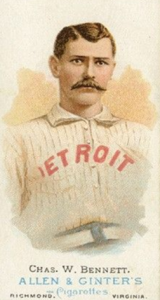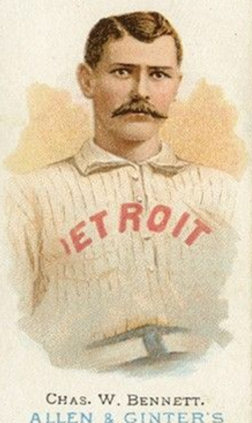June 19, 1886: Chicago White Stockings snap Detroit Wolverines’ 18-game home winning streak
 In 1886 Chicago’s population was five times greater than that of Detroit (about 850,000 to 170,0001), and the Windy City was home to a dominant team of the National League. Under the leadership of superstar Adrian “Cap” Anson, the Chicago White Stockings had won four pennants in the previous six years and achieved an 87-25 record to capture the 1885 flag.
In 1886 Chicago’s population was five times greater than that of Detroit (about 850,000 to 170,0001), and the Windy City was home to a dominant team of the National League. Under the leadership of superstar Adrian “Cap” Anson, the Chicago White Stockings had won four pennants in the previous six years and achieved an 87-25 record to capture the 1885 flag.
The 1885 Detroit Wolverines, with a lackluster 41-67 mark, were 44 games behind the White Stockings. The club moved aggressively in late 1885 to acquire the disbanding Buffalo Bisons, and, notably, Buffalo’s four best hitters. The “Big Four” were Dan Brouthers, Hardy Richardson, Jack Rowe, and James “Deacon” White. Of these, Brouthers was the biggest prize; his .351 batting average from 1881 through 1885 topped even Anson’s .339 average during that period.
With a bolstered lineup, the Wolverines were in first place in the eight-club NL on June 18, 1886. They were 18-0 at home and 12-6 on the road, and 2½ games ahead of the second-place White Stockings. The teams met at Detroit’s Recreation Park for a much-anticipated three-game series, June 19 through 22.
The White Stockings planned to deflate the impertinent upstarts. “Detroit has been putting on some airs about a base ball club which is having the temerity to attack the champions and is elated by some temporary success,” said the Chicago Herald, “and it becomes necessary for the Chicago nine to invade the Detroit stronghold and have it out. The castigation which will then be administered will be complete and salutary.”2
More than 12,000 fans came to the first contest, on Saturday, June 19, “the largest crowd ever at a game in Detroit.”3 To accommodate them, temporary seating was added near the infield, and fans were permitted to stand behind a rope in the outfield. Any ball hit beyond the rope was a ground-rule double.
About 200 rooters had arrived by rail from Chicago. Among them was White Stockings President Al Spalding. The boisterous Chicagoans tooted kazoos and clacked castanets, and waved brooms with signs attached that read “Record Breakers.” The Wolverines’ streak of 18 home wins was the record they hoped would be broken.
It was a beautiful sunny day with a comfortable light breeze. The Wolverines wore all-white attire. The White Stockings were clad in blue uniforms with white caps and, of course, white stockings.4
Anson played first base and managed the visiting team. The home team was managed by Bill Watkins, but on-field decisions were left to Ned Hanlon, Detroit’s center fielder and captain. The sole umpire was John Gaffney.
The Chicago pitcher was Jim McCormick, a 29-year-old right-hander who was undefeated in 11 starts in 1886. The Detroit hurler was a 27-year-old left-hander named Charles “Lady” Baldwin; his season record was 16-2.5 Baldwin was nicknamed “Lady” because he didn’t drink, smoke, or swear.6 Both pitchers were paired with an experienced, first-rate catcher: Michael “King” Kelly for Chicago and Charlie Bennett for Detroit. John Ward of the New York Giants described Bennett as “a veritable stone wall behind the bat” who “could throw to second like a rifle shot.”7
The Wolverines, as the home team, opted to bat first and were scoreless in the first inning. The two rookies in the Chicago lineup produced a run in the bottom of the inning. John Flynn hit beyond the rope in the outfield for a ground-rule double, and he was brought home by Jimmy Ryan’s grounder that bounded barely over the reach of shortstop Rowe. The Wolverines answered in the top of the second. Rowe drove the ball into the crowd in right field for a ground-rule double and scored on Bennett’s single to right.
In the top of the third, Detroit’s Sam Thompson singled to left and went to third on Hanlon’s single to center. Thompson then scored on the front end of a double steal. In the bottom of the inning, Ryan singled over second base. Kelly’s grounder skipped past Brouthers at first base and went into right field. Thompson, the right fielder, gathered it up but made a poor throw to second base, which allowed Ryan to score and Kelly to reach third base.
With only one out, Anson had a chance to put the White Stockings ahead. But he tapped back to the pitcher Baldwin; Kelly got caught in a rundown and was tagged out. Anson tried to reach second base on the play, but he was thrown out by Bennett. After three innings, the score was tied, 2-2.
Each team scored two runs in the fifth inning. In the top of the inning, Brouthers singled to right field and went to third on Thompson’s ground-rule double to left. Hanlon sent them both home with a rousing single to right. In the bottom half, Ryan got aboard by an infield single, his third hit of the game. Kelly’s double was fumbled by Richardson in left field; Ryan scored and Kelly went to third. Anson’s single to right scored Kelly.
Sam Crane stroked a ground-rule double with one out in the top of the sixth and went to third on Richardson’s infield out. Brouthers, the heavy slugger, lifted a pop fly on the infield. He did not run it out, however; perhaps he thought it would go foul. Pitcher McCormick muffed it in fair ground but had plenty of time to throw out Brouthers at first. The Detroit Free Press scolded Brouthers for his “chump act,”8 which probably cost the Wolverines a run. It remained a tie game.
Bennett led off the top of the eighth with a tremendous drive that sailed over rope and fans in the outfield. On any other day, he would have circled the bases for a home run, but on this day, the ground rules limited him to a double. After Baldwin struck out and Crane popped out, Richardson hit an infield single. In a desperate attempt, Bennett tried to score from second on the play. But he was “not a sprinter,” noted the Free Press, and he was thrown out at the plate.9
In the bottom of the eighth, a foul tip from Fred Pfeffer’s bat caught the middle finger of catcher Bennett’s right hand, badly spraining the digit and forcing him to leave the game. Now lacking their star backstop, the Wolverines shuffled their defense. Rowe, the shortstop, replaced Bennett as the catcher. Crane moved from second base to shortstop; Richardson went from left field to second base; and Jack McGeachey entered the game as the new left fielder.
With the score still 4-4, Brouthers led off the top of the ninth with a single to right field. After Thompson fouled out, Hanlon’s single up the middle sent Brouthers to third base. But the Wolverines failed to capitalize. Hanlon was thrown out trying to steal second, and Rowe grounded out.
McCormick led off the bottom of the ninth with a single to right field, and he advanced to second base on Rowe’s passed ball. George Gore stepped to the plate, and a foul tip from his bat severely injured one of Rowe’s fingers. Foul tips were an awful hazard, and “no catcher could avoid banged-up fingers.”10
Rowe was replaced by Charlie Ganzel, Detroit’s third catcher of the day. Gore singled to left field and McCormick went to third base. With Flynn at bat, Baldwin let loose a wild pitch, and McCormick stormed home with the winning run. It was a strange finish to an exciting game. The final score was Chicago 5, Detroit 4.
The Wolverines’ 18-game home winning streak was broken. They lost not only the game but two catchers to injury. Ganzel, however, filled the position ably as the Wolverines defeated the White Stockings in the remaining games of the series by scores of 4-1 on June 21 and 5-4 on June 22. Rowe returned to the Detroit lineup on June 29 and Bennett on July 7.11
The White Stockings and Wolverines battled for first place throughout the 1886 season. The Wolverines’ 8-3 victory in Chicago on September 9 snapped the White Stockings’ 13-game home winning streak. In the end, the White Stockings won the pennant, finishing 2½ games ahead of the Wolverines.
Sources
In addition to the sources cited in the Notes, the author accessed Baseball-Reference.com and Retrosheet.org for pertinent information.
Game coverage in the June 20 and June 21, 1886, issues of the Detroit Free Press; the June 20, 1886, issue of the Chicago Tribune; and the June 21, 1886, issue of the Fort Wayne (Indiana) News.
Image: Baseball card of Charlie Bennett made in 1888 by the Allen & Ginter Tobacco Company of Richmond, Virginia. Bennett was selected as SABR’s Overlooked 19th Century Base Ball Legend of 2021.
Acknowledgments
This essay was fact-checked by Kurt Blumenau and copy-edited by Len Levin.
Notes
1 Population figures estimated from the 1880 and 1890 US Census numbers.
2 Reprinted in Detroit Free Press, June 21, 1886: 5.
3 Sporting Life, June 30, 1886: 2.
4 “1886 Chicago,” Threads of Our Game: 19th Century Uniform Database, accessed February 13, 2024, https://www.threadsofourgame.com/1886-chicago/.
5 The pitchers’ season records were determined by the author from box scores.
6 “Hero of Champion Ball Team Denies He Was an Iron Man,” Detroit Free Press, July 26, 1936: 8.
7 Alfred H. Spink, The National Game (St. Louis: National Game Pub. Co., 1911), 94.
8 “The Record Broken,” Detroit Free Press, June 21, 1886: 5.
9 “The Record Broken.”
10 Peter Morris, Catcher: How the Man Behind the Plate Became an American Folk Hero (Chicago: Ivan R. Dee, 2009), 76.
11 “The Worm Turns,” Detroit Free Press, June 30, 1886: 8; “For Other Fields,” Detroit Free Press, July 8, 1886: 8.
Additional Stats
Chicago White Stockings 5
Detroit Wolverines 4
Recreation Park
Detroit, MI
Corrections? Additions?
If you can help us improve this game story, contact us.


